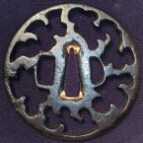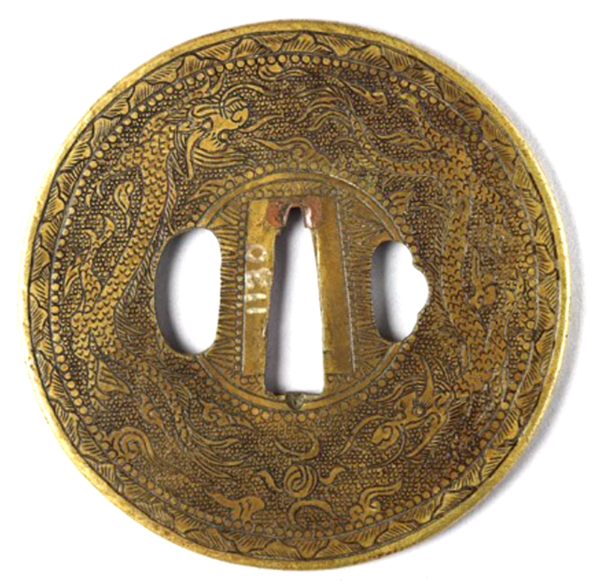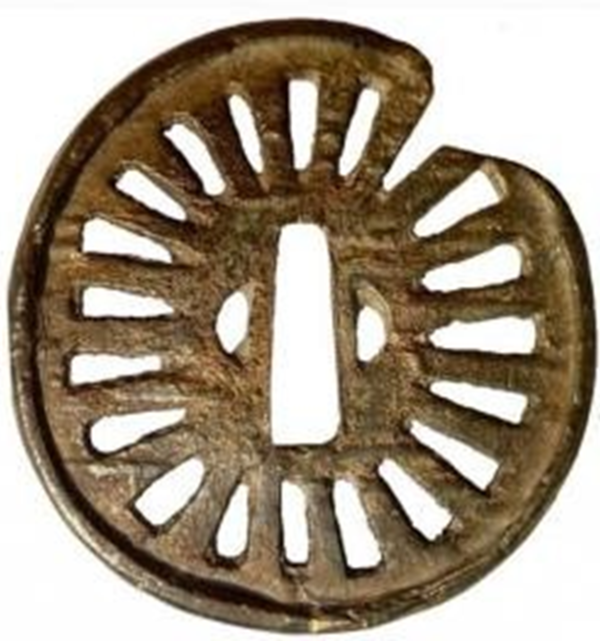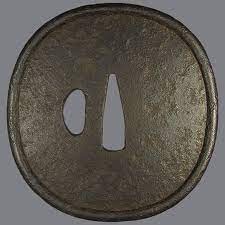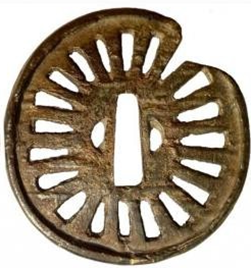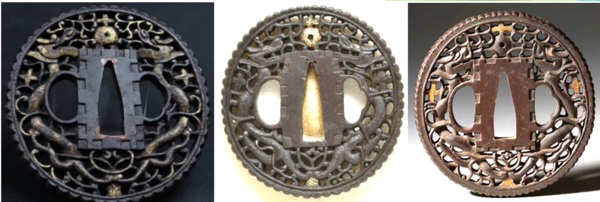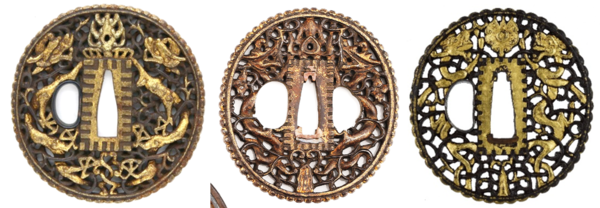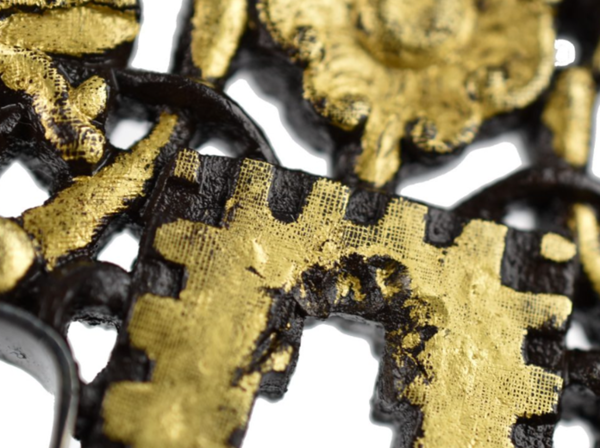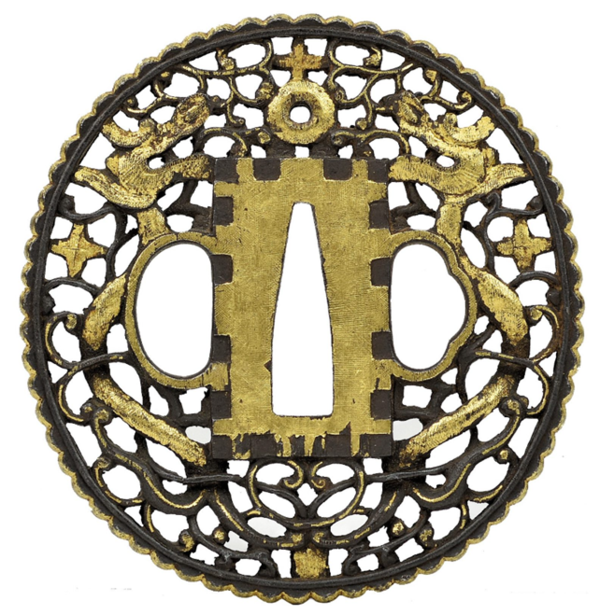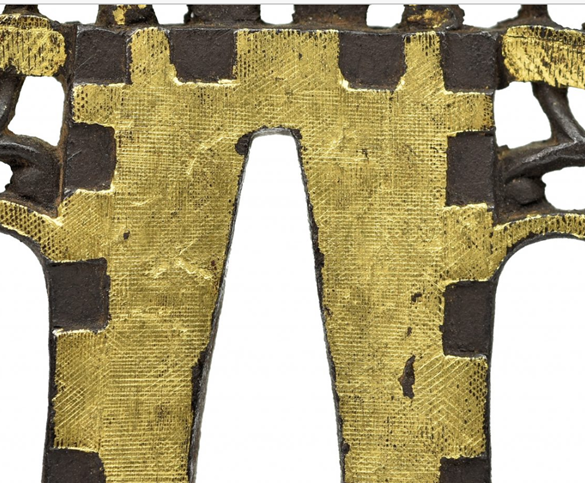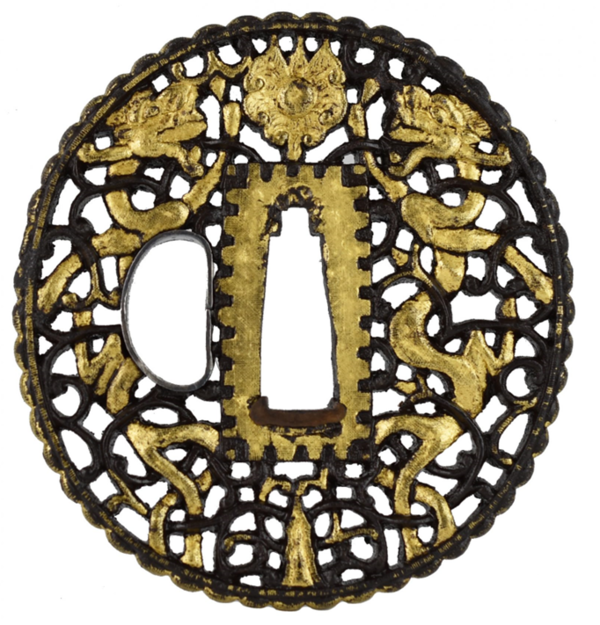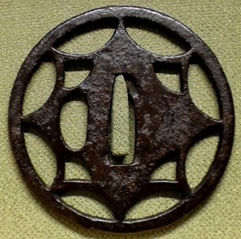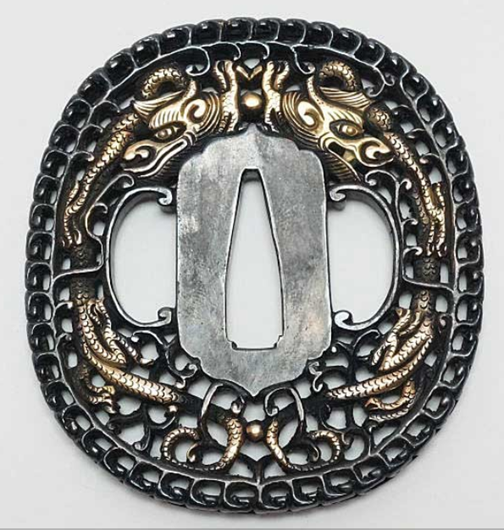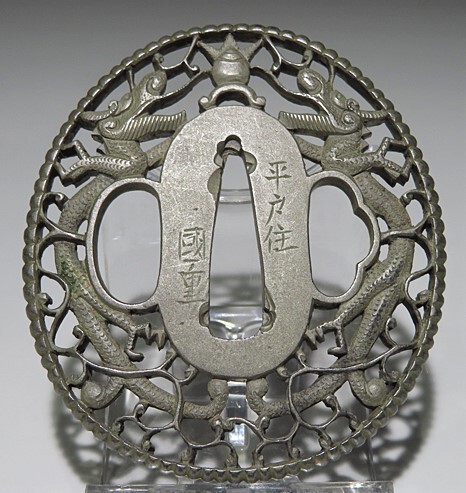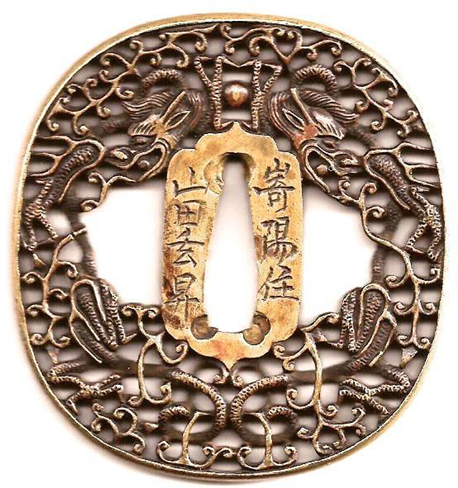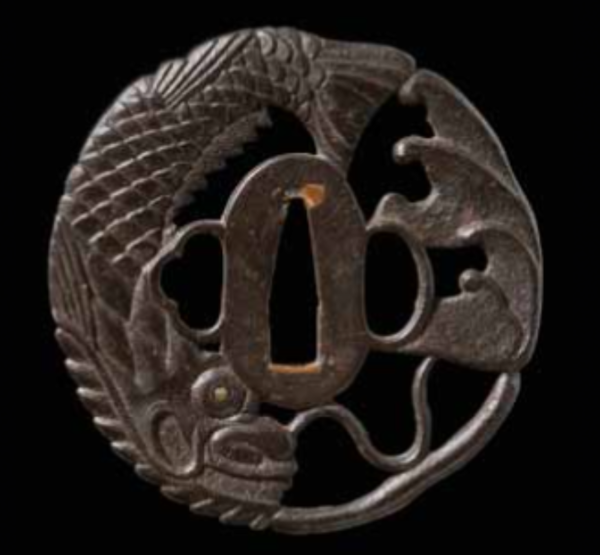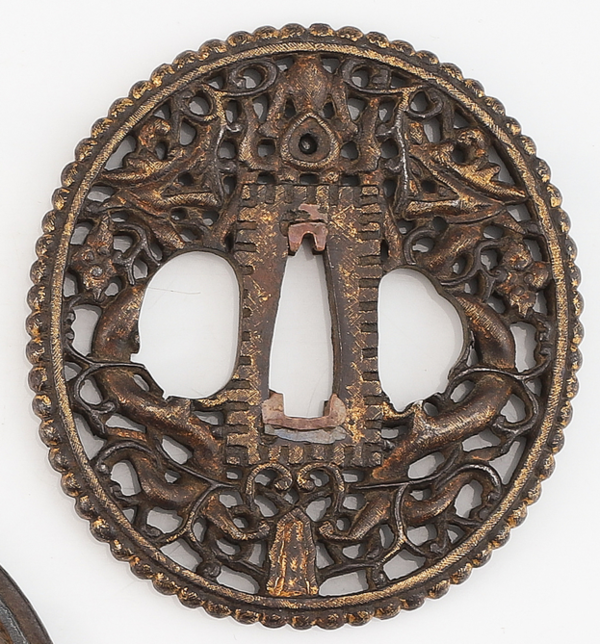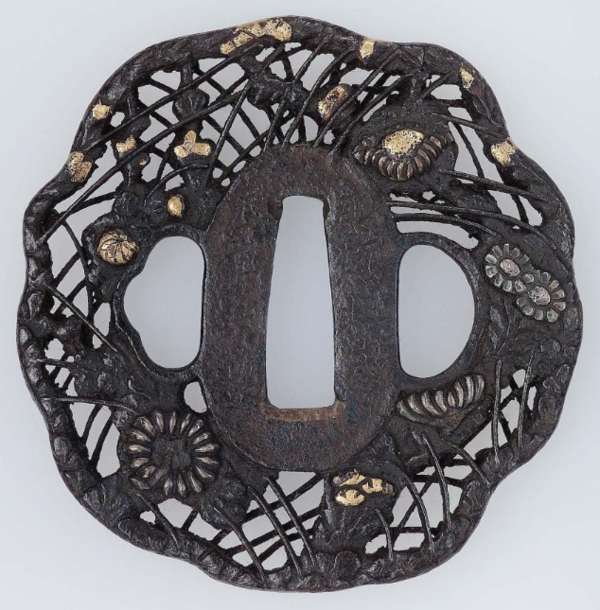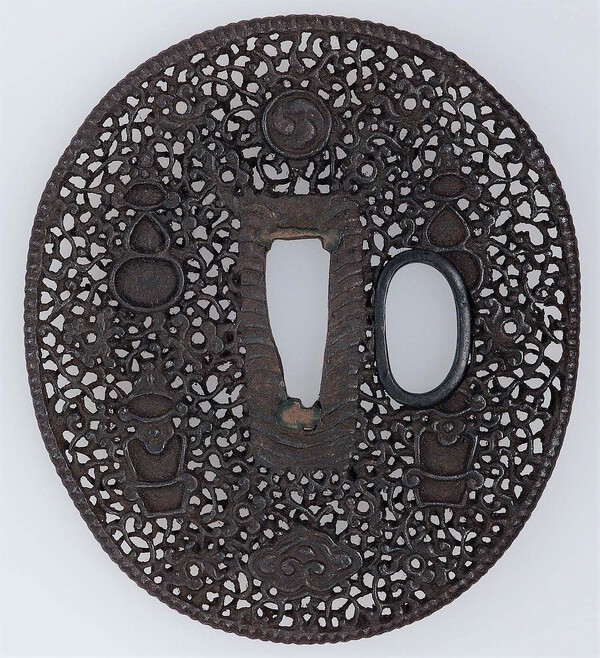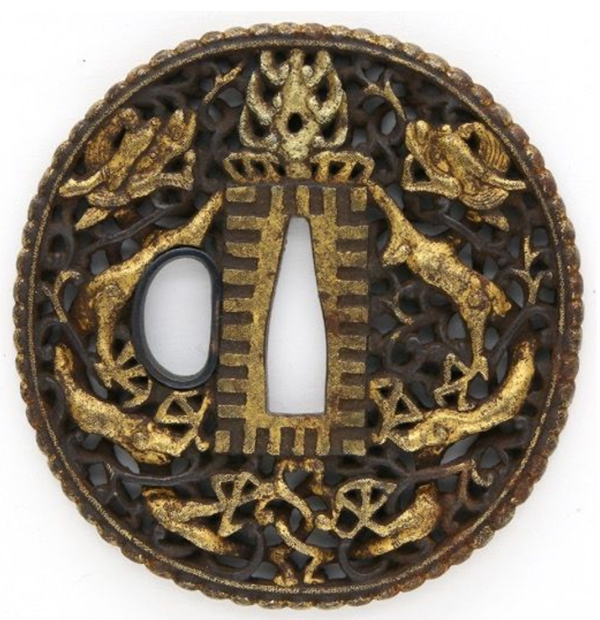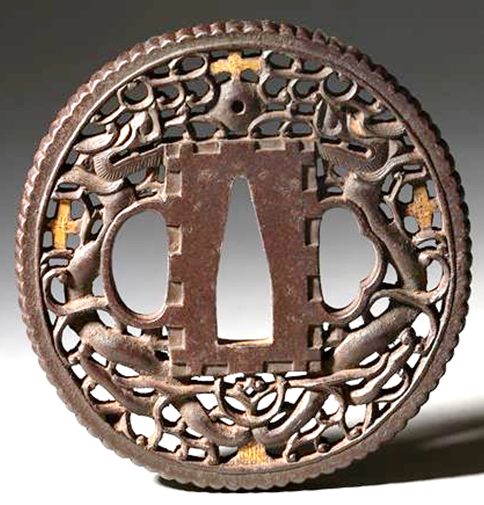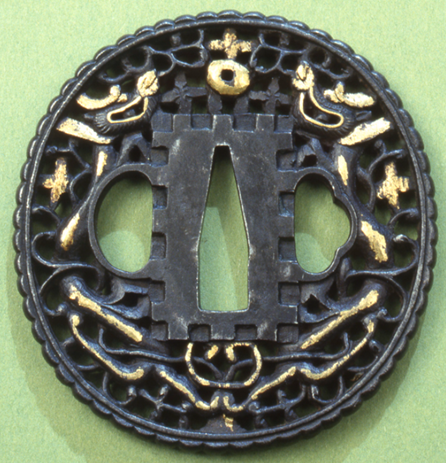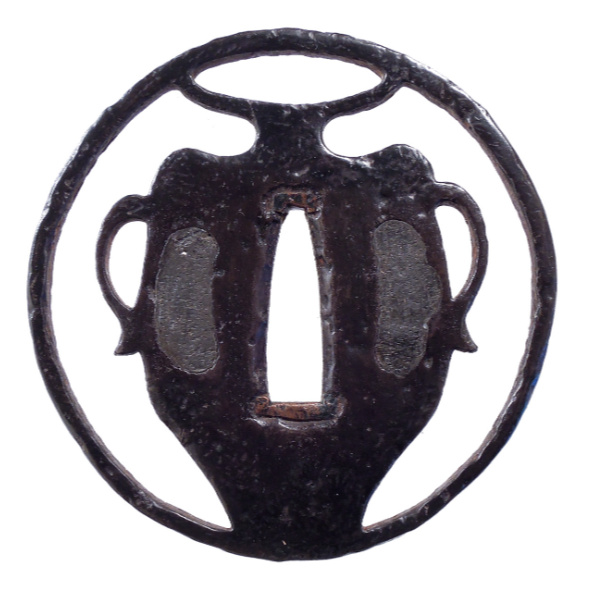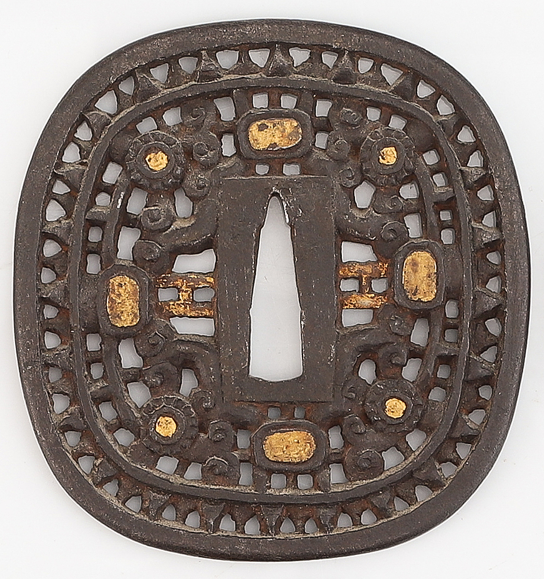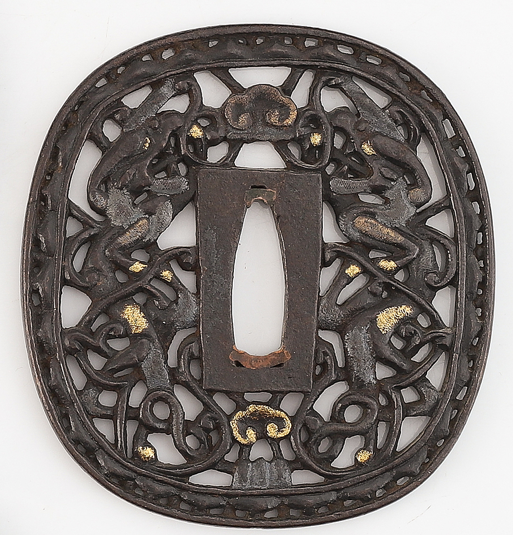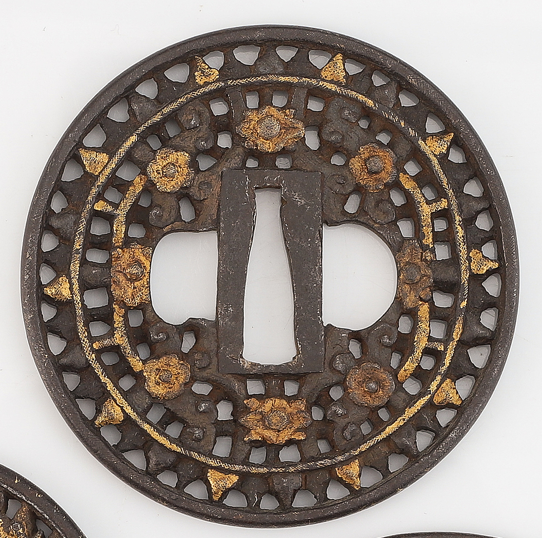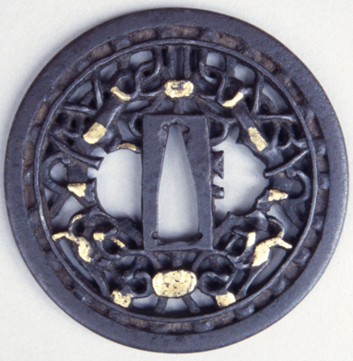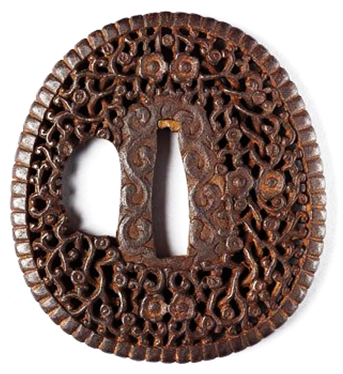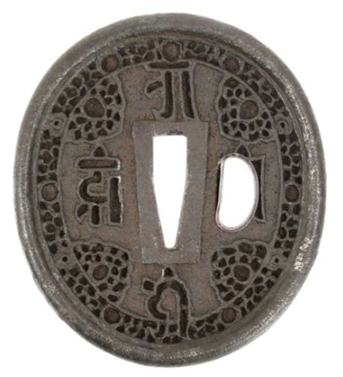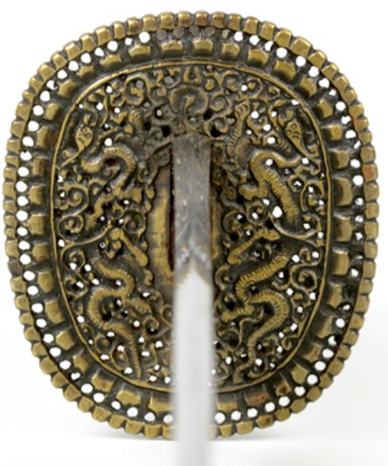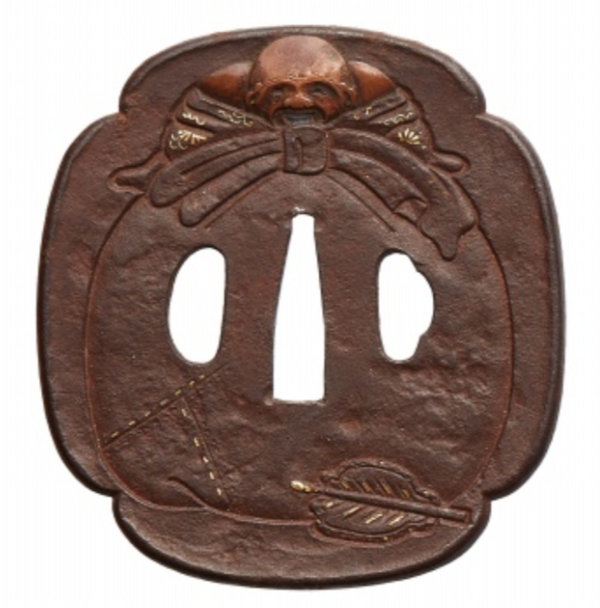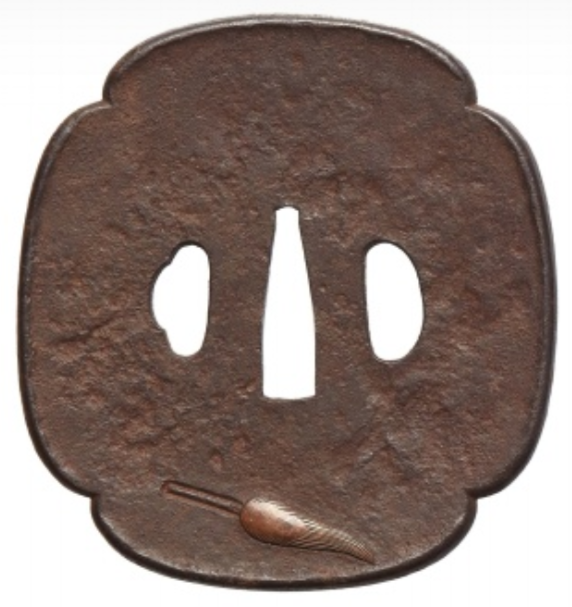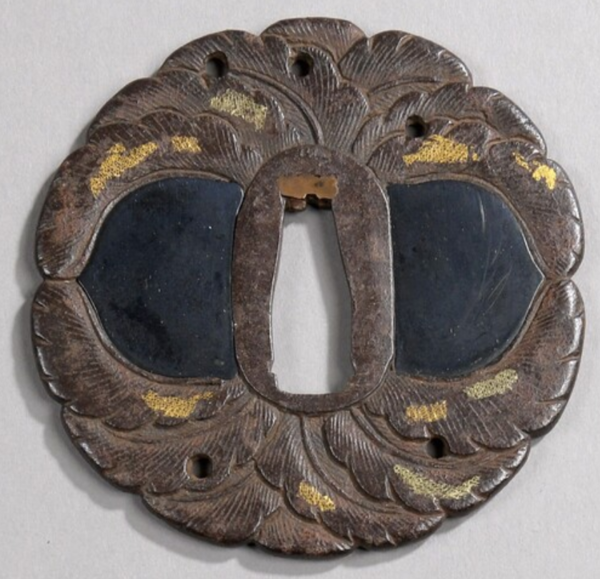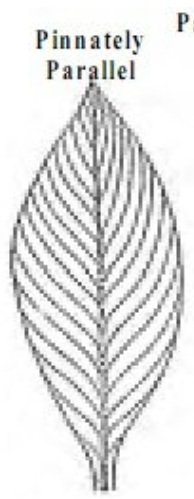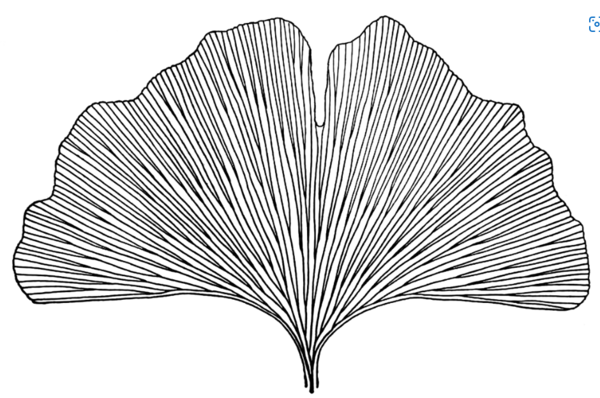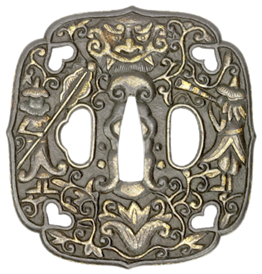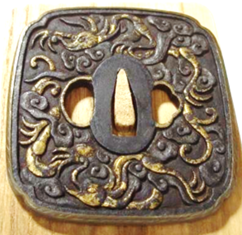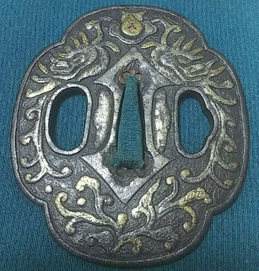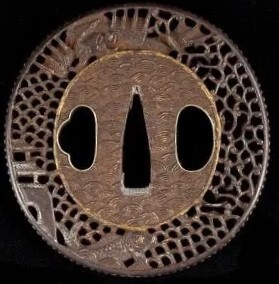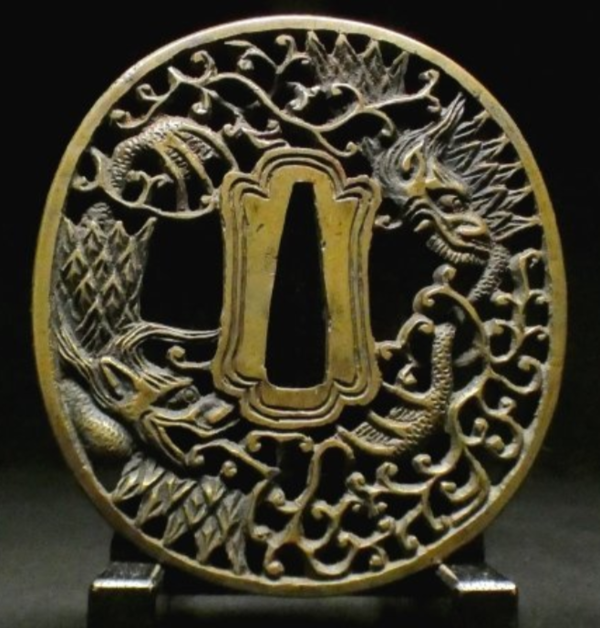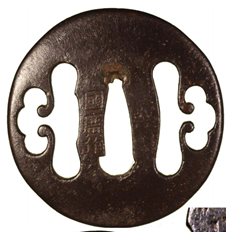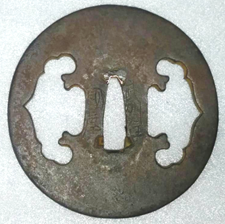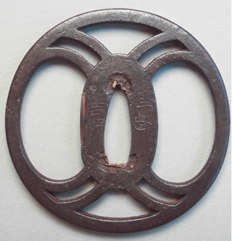-
Posts
594 -
Joined
-
Last visited
-
Days Won
10
Content Type
Profiles
Forums
Events
Store
Downloads
Gallery
Everything posted by GRC
-
Kiril, I have never seen anything quite like the one you posted, so i'm not too sure what to make of it. It also looks like something that was dug up from an ancient burial mound somewhere... Guess number 1: It originated in Continental Asia because of the rectangular nakago-ana and slightly egg shaped profile, and it was never intended for use in Japan. and now for something completely different... It does appear to have been made in the Japanese "katchushi style", with the raised, rounded rim. That guruma (wheel) sukashi motif was also very popular in the Momoyama period of Japan. So guess number 2: Maybe it was originally a Japanese made katchushi style tsuba with a plain plate and no hitsu-ana, then exported to continental Asia, where it was roughly chiseled into a guruma sukashi pattern, and the nakago-ana cut into a large tapered rectangle, and two tiny unuseable "hitsu-ana" were added in to give the plain katchushi tsuba a slightly more "contemporary" and updated Japanese look. Just running with the idea, but I could be completely off base on this one... I've got several image examples of Japanese katchushi style and tosho style tsuba that were presumably exported, then modified in continental Asia. But, they are usually modified with extensive nunome overlays, so this would be the first one I've seen with added sukashi elements. The sukashi does look pretty roughly done, so more likely to have been done by an amateur after the tsuba was originally produced. In terms of where in Asia: I'm leaning more specifically towards a Vietnam because of the wide rectangular, tapered nagako-ana, but with a fairly large rounded seppa-dai area surrounding it. Here's an example of a carved soft metal one with these 2 distinct attributes: Anyone else want to weigh in on this one?
-
Roger, I think you and Piers are 100% correct. Every one of the this style of of double dragon with the castellated seppa-dai (with the wider, more square rather than slotted indents) has the cross instead of the typical pearl. I actually had to look up "castellated", so thanks for the new word here's just a few of the Japanese ones of this type: The longer, more slotted indents only show up on the Chinese ones, which don't have the crosses, and have a lot more variation in their dragon head shapes.
-
I came across two great examples of Chinese vs Japanese versions of that same double dragon themed tsuba I posted above. The images were also detailed enough to catch a glimpse of the 2-directional Chinese nunome vs 3-directional Japanese nunome. The 2-way pattern is definitely Chinese. However, I don't know if the Chinese smiths ever adopted the three-way pattern outside of the Chinese smiths who ended up living and working in Japan. So I can't say with certainty that the presence of the three way pattern is an absolutely certain sign that the tsuba was made in Japan, although it'll still be a very "safe" assumption. As with most tsuba, there gets to be this grey area of crossover in style and technique amongst different smiths in the same and/or different areas, and even in different time periods. Often those "mysteries" are part of the fun... but sometimes they can be a frustrating nightmare, and you just have to accept that you might never be able to find a clear answer The result is that you'll always find examples that become a "toss-up" in terms of classifying and you just have to throw yours hands up Chinese (again, note the cutout hitsu-ana and the added hitsu-ana ring): Japanese (original hitsu-ana):
-
Unusual seppa-dai and hitsu-ana arrangement, making an 8-point web-shape... maybe a nod to the 8 Buddhist principles? 8 points like these tsuba:
-
I had one more example on file... I've got roughly 1500 Nanban tsuba images I've been building up and trying to sort/classify: OK, I know that's a little obsessive...
-
I have one other on file like Geraint's, but it's signed by a Japanese smith (Yamada Gensho), living in Nagasaki ("Kiyou"). Both are almost certainly work from the same school in Nagasaki. Here's one of my Japanese-made Nanban, with very finely, vertically chiseled tendrils (rather than rounded). It's also made of non-magnetic soft-metal that has a slight greenish-khaki-grey colour. It's the only tsuba I have that is even remotely close to this color. I suspect it's some form of shibuishi maybe?
-
-
Hi Peter, Here's what I recall from the searching I've been doing on these for a while now. The dates will range from the Momoyama period (when there were many global influences on Japanese art and culture), all the way till the end of the Edo period. After the unification of Japan, marking the beginning of the Edo period, Japanese borders were mostly closed for trade (except two ships per year from the Dutch East India Company and an unknown number of ships from the East Asian continent - or at least "unknown" to me). During this extended period of Edo period isolationism, I presume it would have been a necessary shift towards making most of these guards in Japan. The Nagasaki nanban school in Japan had Chinese smiths living in Nagasaki, producing nanban tsuba for the Japanese market. The height of popularity of nanban guards in Japan was during the mid to late Edo period. btw your third one with the very fine "tendrils" that arc over each other like branches in a bird's nest, reminds me of this style of nanban work, which is not very common at all. (This one is from the MFA museum in Boston) (ttps://collections.mfa.org/objects/15216/tsuba-with-design-of-chrysanthemums-and-daisies?ctx=dde6abbf-785c-46bf-8962-3eaefa1b711c&idx=1) Interestingly, this one is signed by a Chinese maker (very rare to see that), but unlike the one you posted, this one was made with the intent for sale in Japan because of the shape of the seppa-dai and the purposeful hitsu-ana. It is also dated by the smith himself, to the late 1600s-early 1700s: 康煕未歳長楽交造 南京寓長楽交造 Koki hitsuji-sai Cho Rakko tsukuru Nankingu Cho Rakko tsukuru [Made by Cho Rakko (Zhang Lejiao) in the goat year of the Kangxi period (=1667, 1679, 1691, 1703, 1715); Nanjing resident Cho Rakko] Here's two examples of a Chinese guard theme that was later produced in Japan in large numbers: Later Japanese versions: Here's another egg shape Chinese one, intended to be worn blade edge down, and it has an added shakudo-outlined hitsu-ana (also in the MFA):
-
maybe a variation of this one? Some sort of fruit maybe? nope, scratch that, definitely aliens...
-
looks good to me Here's one with what looks like the same motif, which was described as "chatsubo". Chatsubo 茶壷 in Japanese is the name of the clay pots used to keep matcha tea leaves before they get ground
-
Can't comment on the first one... sorry. The second one with the egg shaped form is typical of an early Chinese guard (which I'm pretty sure are called "Hushu"), but has none of the typical "Nanban" aesthetic, so probably made in China and probably never exported to Japan. The third one you posted is definitely not Japanese made or modified to fit a Japanese blade. Likely made in China for a Chinese blade. Here are some more egg shapes made in China for Chinese blades (worn blade edge down like a tachi), with a more typical "nanban" aesthetic. Both were modified in Japan to have a hitsu-ana: Here's one that is unmodified and mounted on a Chinese Dao sword: Here are some unmodified Chinese guards (except maybe the nakago-ana): and these three Chinese guards had the design cut through later, to make 2 hitsu-ana to fit a Japanese koshirae:
-
This one is Hotei behind a large bag, with a radish on the back. Clearly not the same as what you posted David... but maybe a similar concept? Maybe they are both some sort of "blessing for a good harvest"?
-
Bruno, that tsuba was originally described as "arching feathers" when sold by an auction house in France I happened to stumble across it by accident this morning while looking for something else. My vote is feathers as well, although the feathers are arranged in such a way as to give the same "look" as the ginko leaves in the tsuba that Dale posted. So maybe it's an intentional "double visual". Maybe someone was trying to combine their family's feather mon with a ginko leaf motif? Those leaf shapes Dale posted typically represent ginko leaves, which have diverging, almost parallel veins, that can branch in two along their paths. It's called a "dichotomizing vein pattern": But, they are typically done as simple diverging lines when done as inlays on tsuba (likely for simplicity). Whereas the tsuba Bruno posted has what is called a "pinnately parallel" pattern... which is found in leaves of many plant species, but also bird feathers
-
That's the first time I have seen the "overweight" version of the bird tsuba It would be pretty subtle once mounted on a sword and viewed from a "safe" distance by onlookers back in the day. Seems almost like an intentionally "hidden" motif.
-
Wan-gata forms are rare for this particular style of Nanban tsuba carving and overlay. But I guess you could probably say the same for just about any wan-gata form... so I suppose that isn't saying much lol What is definitely unusual though, is having a distinct, raised seppa-dai on the concave side of the curved dish. Here are some other examples of "this style" of Nanban tsuba, but not in the wan-gata shape. The first one below has more sharply defined carving than the typical, but they all seem to favor more blocky/bubbly, almost "childlike" or "folk-art" types of design (not too sure how else to describe it).
-
Congrats on the start of your new addiction The steel should clean up fairly well with some scraping with antler or ivory. It will even out the appearance of the steel surface once you get those tiny rust bubbles off the surface. Don't use any metal wire brushes of any kind or you'll scratch through the patina that that gives it an aged appearance. Also make sure not to scrape the gold overlay with anything or you'll take it right off.
-
I think you're probably right Dale. The hitsu-ana liners were most likely added later, and probably even the hitsu-ana themselves. It's really rare to have white-metal liners in the hitsu-ana of a Nanban tsuba. Although there does appear to be some silver nunome on the castle's outline... so it was a good choice by whoever added them in. And, as you pointed out, the large round seppa-dai is more of a continental East-Asian layout, rather than specifically Japanese. I love how the waves are simple repeated arcs on the left side, then get more random toward the upper right side. This is definitely a top-notch Nanban tsuba.
-
Outstanding detective work Dale!
-
Beautiful workmanship on that one Dale Spotted another nanban tsuba variation that has a castle and fish as well, with an unusually large and round seppa-dai for a nanban tsuba:
-
-
Dale, it's this version from page 1:
-
Looks like the exact same guard Dale posted, relisted three years later by an online dealer. Cleaned up beautifully, but a much higher price this time (10x ) I wonder how many times it changed hands from 2019 to 2022.
-
Piers, Dale is correct , yours is more likely Inshu Suruga, or possibly Bushu Ito. The distinct "kuchi-beni"-style sekigane is a dead giveaway, but other schools also adopted that sekigane style afterwards, like Bushu and Akao. Ineterestingly, here's two Suruga tsuba that put their spin on the boat rudder motif that we also see in Teimei works: The sukashi is too curvy and flower-like for Teimei. Teimei tends to do long smooth arcs or straight line geometrics, not undulating curves. Here are some Teimei examples with curves (and note, none of them have kuchi-beni sekigane): Here's one which I have in my Suruga files, but I can't be 100% certain on this one... Often though, the Suruga smiths like putting in really fine-line sukashi elements, like the super thin lines in the rudder tsuba above. So, another option is the Bushu Ito school which did these bold flower-like, large symmetrical sukashi: Kunihiro from Bushu Ito did a lot of work like your tsuba, and he used kuchi-beni sekigane: Here's another Bushu by Masamichi (at least that's what the description said): Sorry for taking this thread off track Jean. At least the boat rudder examples tie in a bit.. sort of Unfortunately, I can't help you out with the chronology of the different Teimei signatures. .


